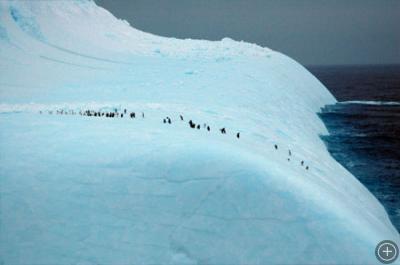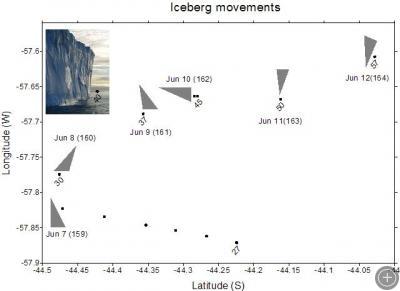Our Changing Iceberg
SCOTIA SEA, SOUTHERN OCEAN– Icebergs in the Southern Ocean are constantly moving and transforming.
SS-1, the iceberg we are currently studying, is considered a “medium” iceberg. When we arrived, it was 2.3 nautical miles long and about 0.25 miles in its wider dimension, the shape being somewhat triangular. Since we started work here six days ago, the iceberg has been displaced about 13 nautical miles north and 14 nautical miles east for a total of 22 nautical miles in a curved path. Rotation is also noticeable.
John Helly is studying the influence of tides, currents and wind on the iceberg’s movement. It is possible that all of this movement stirs the upper 300 meters of water in such a way that it increases phytoplankton growth around the berg.
But different locations aren’t the only changes this iceberg is consistently undergoing: Iceberg SS-1 is breaking.
Yesterday around noon SS-1 lost about 10 percent of it mass. The tip broke off; the shape is now more rectangular than triangular.
We have had northerly winds with temperatures above freezing point for the last few days. The seawater is somewhat warm as well, at -0.2 degrees centigrade. All of these factors seem to have combined to accelerate the iceberg’s disintegration.

The piece that broke off from Iceberg SS-1. The curved slope was submerged underwater until it broke free, leaving a gathering place for chinstrap penguins.
We spent the afternoon studying the new smaller iceberg that broke off. Steve Rock and Johanna O’Neill mapped the iceberg’s underwater surface with a multibeam sonar. One side was constantly crumbling, making the surrounding waters fresh and cold.
The iceberg rebounded with its previously submerged areas now exposed to air. Forty or fifty penguins came in the afternoon to check out the new iceberg and stayed a while.

 No comments
No comments 







